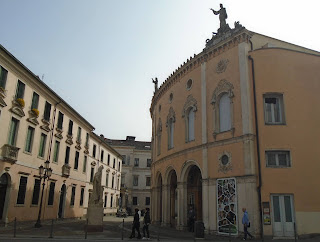Sculpture stands outside Teatro Verdi
 |
| The statue of Angelo Beolco stands opposite the Teatro Verdi (photo by DracoRoboter via Wikimedia Commons) |
It commemorates one of the most powerful Italian dramatists of the 16th century, Angelo Beolco - also known as Ruzzante or Ruzante - who was born in Padua and died in the city on 17 March 1542.
Beolco was famous for his rustic comedies, which were written mostly in the Paduan dialect of the Venetian language.
Many of his plays featured a peasant called Ruzzante and they painted a vivid picture of life in the Paduan countryside during the 16th century.
Beolco was born in Padua in 1496 and was the illegitimate son of a doctor. His mother was possibly a maid in the household where he was brought up by his father. He received a good education and after his father’s death became manager of the family estate. In 1529, he also became manager of a farm owned by a nobleman, Alvise Cornaro, who had retired to live in the Paduan countryside. Cornaro later became Beolco’s friend and protector.
Beolco met and associated with Paduan intellectuals of the time, such as the poet Pietro Bembo and the scholar and dramatist Sperone Speroni, which led to him developing an interest in the theatre.
His first attempts at acting and writing plays may have been delivering impromptu sketches at wedding parties.
 |
| Angelo Beolco was born in Padua in 1496 and spent much of his life there |
In Beolco’s first printed play, La pastoral, which was categorised as a rural comedy, Arcadian shepherds tell of their frustrated love affairs, while, in contrast, the peasants Ruzzante and Zilio deliver rustic verses in dialect, spiced with vulgarities and obscenities, beginning with Ruzzante’s first line in the play.
Much of the play’s comical effect comes from the contrast between the two languages, which provides the opportunity for misunderstandings and plays on words.
In his later plays and monologues, Beolco shifts more to the Venetian language, while maintaining his social satire.
Beolco’s plays were sometimes considered unfit for educated audiences because of the lascivious themes and vulgar language and this occasionally led to performances being cancelled.
In one of his best-known pieces, Il parlamento de Ruzante, the character tells of his return from the Venetian war front only to find that he has lost his wife, land and honour. The speech begins with Ruzzante’s favourite expletive.
Linguistic studies have concluded that Ruzzante’s speech was not an accurate record of Paduan dialect of the day, but to some extent, a theatrical dialect created by Beolco.
 |
| The Teatro Verdi, built in the 18th century, is named after the composer Giuseppe Verdi |
Beolco (Ruzzante) wrote at least 11 plays and monologues, but died in Padua when he was in his late forties, while preparing to stage a play by his friend, Speroni, for the Accademia degli Infiammati. Despite his theatrical success, Beolco was very poor for most of his life. Speroni once remarked that, while Beolco had an unsurpassed understanding of comedy, he was unable to perceive his own tragedy.
The statue outside the Teatro Verdi is the work of the 20th century sculptor Amleto Sartori - also from Padua - who was most famous for creating the theatrical masks used when Commedia dell’Arte enjoyed a brief revival in the mid-20th century.
To find the Teatro Verdi and see the Ruzzante statue, taking the Piazza dei Signori in the centre as the starting point, walk north along Via Dante Alighieri from the Torre dell’Orologio and turn left into Corso Milano. Piazza Terrani and the theatre are about 150 yards (137m) along on the left.
The beautiful 18th century theatre now presents operas, musicals, plays, ballets and concerts organised by the Teatro Stabile del Veneto.
No comments:
Post a Comment